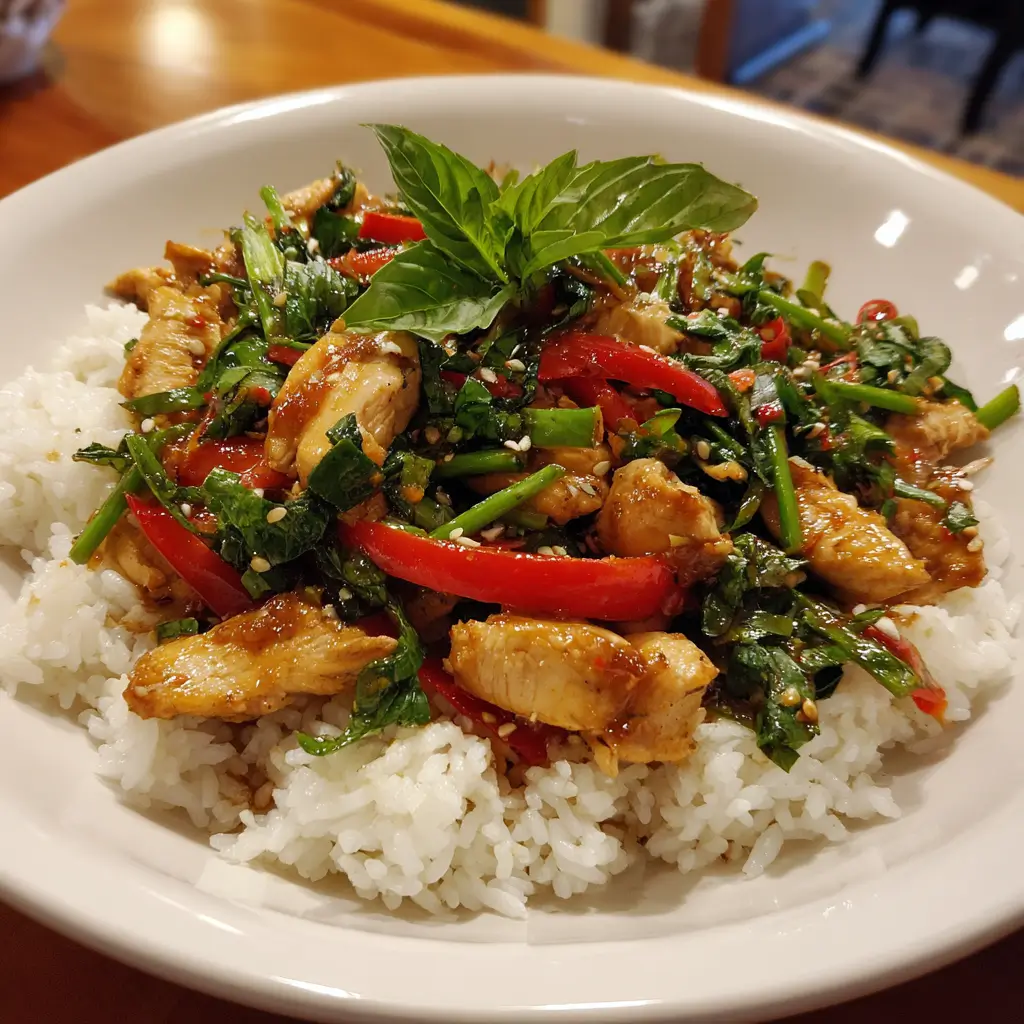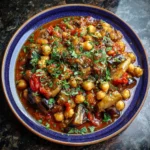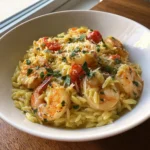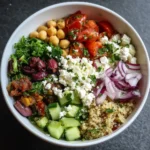Thai Basil Chicken Stir Fry: A Flavorful Journey Through Thailand’s Beloved Street Food
When it comes to vibrant, aromatic, and deeply satisfying Southeast Asian cuisine, few dishes capture the essence of Thai street food quite like Thai Basil Chicken Stir Fry, known locally as Kai Pad Krapow (or Gai Pad Kra Pao). This sizzling stir-fry combines tender pieces of chicken with the bold flavors of garlic, chili, fish sauce, and holy basil, all cooked at high heat to create a dish that’s both fiery and fragrant. Served traditionally over steamed jasmine rice and crowned with a fried egg, this meal is a staple in homes and roadside stalls across Thailand. Whether you’re a seasoned cook or new to Thai cooking, mastering this recipe opens the door to an authentic taste of Thai culture—right from your kitchen.
The History of Thai Basil Chicken Stir Fry
Thai Basil Chicken Stir Fry has deep roots in Thai culinary tradition, originating as a quick, affordable meal for busy workers and families. Its popularity surged in the early 20th century as urbanization increased and street food vendors began serving fast, flavorful meals to laborers and office workers alike. The dish was born out of necessity—using readily available ingredients such as ground or chopped chicken, pungent garlic, spicy chilies, and the uniquely scented holy basil (bai krapow), which grows abundantly throughout Thailand.
The use of holy basil is what sets this dish apart from other stir-fries. Unlike sweet basil used in Italian cuisine or Thai sweet basil (horapa), holy basil (Ocimum tenuiflorum) has a peppery, clove-like flavor with a hint of spiciness, making it ideal for savory meat dishes. Over time, Kai Pad Krapow evolved into a national favorite, symbolizing the balance of spicy, salty, sweet, and umami that defines Thai cooking. Today, it’s not only a comfort food but also a culinary ambassador of Thai flavors around the world.
Ingredients Breakdown: What Makes This Dish Shine?
The magic of Thai Basil Chicken Stir Fry lies in its simplicity and harmony of ingredients. Each component plays a vital role in building layers of flavor, aroma, and texture. Here’s a detailed breakdown:
- Chicken: Traditionally, minced (ground) chicken is used for its quick cooking time and ability to absorb flavors. However, finely diced chicken breast or thigh can be substituted depending on preference.
- Holy Basil (Bai Krapow): The star herb. It imparts a warm, slightly spicy, and medicinal aroma that cannot be fully replicated by other basils. If unavailable, a mix of Thai sweet basil and mint may work in a pinch, though the flavor will differ.
- Garlic: Freshly minced garlic provides a pungent base note, essential for building depth in the dish.
- Chili Peppers: Bird’s eye chilies (prik kee noo) are traditional, offering intense heat. Adjust quantity based on spice tolerance.
- Fish Sauce (Nam Pla): A cornerstone of Thai cuisine, it adds saltiness and umami richness without overpowering the dish.
- Dark Soy Sauce: Used sparingly to add color and a subtle sweetness, enhancing visual appeal without making the dish overly sweet.
- Oyster Sauce: Contributes a savory, slightly sweet depth and helps thicken the sauce slightly.
- Sugar (Palm Sugar Preferred): Balances the saltiness and heat; palm sugar adds a caramel-like nuance, but brown or white sugar works too.
- Cooking Oil: A neutral oil with a high smoke point, such as vegetable or peanut oil, is ideal for stir-frying at high heat.
- Jasmine Rice: The classic accompaniment—fragrant, fluffy, and slightly sticky—to soak up the flavorful sauce.
- Fried Egg (Optional but Traditional): A runny-yolk fried egg placed on top adds richness and completes the dish.
Step-by-Step Recipe: How to Make Authentic Thai Basil Chicken Stir Fry
Follow these steps carefully to achieve the perfect balance of textures and flavors:
- Prepare Ingredients: Mince 4 cloves of garlic and slice 2–3 bird’s eye chilies (adjust to taste). Chop 1 lb (450g) of chicken into small pieces or use ground chicken. Rinse and drain 1 cup of fresh holy basil leaves. Have all sauces measured and ready—this is crucial for stir-frying.
- Heat the Wok or Pan: Place a wok or large skillet over high heat until very hot. Add 2 tablespoons of oil and swirl to coat the surface.
- Sauté Aromatics: Add the minced garlic and sliced chilies. Stir-fry for about 15–20 seconds until fragrant but not burnt.
- Cook the Chicken: Add the chicken to the wok. Break it apart with your spatula and stir-fry for 2–3 minutes until mostly cooked through and beginning to brown slightly.
- Add Sauces: Pour in 2 tablespoons of fish sauce, 1 tablespoon of oyster sauce, 1 teaspoon of dark soy sauce, and 1 teaspoon of sugar. Stir well to combine and continue cooking for another 1–2 minutes until the chicken is fully cooked and the sauce coats the meat evenly.
- Incorporate Holy Basil: Add the holy basil leaves and toss quickly into the mixture. Cook for just 20–30 seconds until the leaves are wilted but still vibrant green. Do not overcook, as they will lose their fragrance.
- Taste and Adjust: Give the dish a quick taste. You can add a splash more fish sauce for saltiness, a pinch of sugar for sweetness, or extra chili for heat.
- Serve Immediately: Spoon the stir-fry over a bed of hot steamed jasmine rice. Top with a fried egg if desired—preferably with a runny yolk.
Tips for the Perfect Thai Basil Chicken Stir Fry
- Use High Heat: Authentic stir-frying requires intense heat to sear the meat quickly, lock in juices, and develop a smoky flavor (wok hei).
- Prep Everything Ahead: Stir-frying is fast-paced. Having all ingredients chopped, measured, and within reach ensures smooth execution.
- Don’t Overcrowd the Pan: Too much chicken at once lowers the temperature and causes steaming instead of frying. Cook in batches if necessary.
- Fresh Holy Basil is Key: Avoid dried or substituted herbs when possible. Look for it in Asian grocery stores or farmers’ markets.
- Balance Your Flavors: Taste as you go. The final dish should be savory, slightly sweet, spicy, and aromatic—not overly salty or bitter.
- Fried Egg Perfection: Cook the egg in the same wok after wiping it clean, using a little butter or oil. Aim for crispy edges and a soft, runny yolk.
- Serve Immediately: This dish loses its vibrancy if left sitting. Serve hot, straight from the wok.
Variations and Customizations
While the classic version uses chicken, Thai Basil Stir Fry is incredibly adaptable. Here are some popular variations:
- Protein Swaps: Use ground pork, beef, turkey, shrimp, or tofu for vegetarian versions. Each brings a different texture and flavor profile.
- Vegetarian/Vegan Option: Replace fish sauce with soy sauce or vegan fish sauce alternative, omit oyster sauce (or use mushroom-based oyster sauce), and use tofu or tempeh.
- Extra Vegetables: Add bell peppers, snap peas, mushrooms, or baby corn during the last minute of cooking for added crunch and nutrition.
- Spice Level Control: Remove chili seeds for milder heat, or add extra chilies and a dash of chili oil for extreme spice lovers.
- Noodle Version: Toss the stir-fry with rice noodles or egg noodles for a hybrid dish similar to Pad Kee Mao (Drunken Noodles).
- Crispy Toppings: Garnish with crushed peanuts, fried shallots, or crispy garlic bits for added texture.
- Regional Twists: In Northern Thailand, fermented fish sauce (pla ra) might be used; in Southern regions, turmeric or coconut milk could be incorporated subtly.
Health Considerations and Nutritional Value
Thai Basil Chicken Stir Fry can be a healthy, balanced meal when prepared mindfully. Here’s a nutritional overview per serving (approx. 1 cup stir-fry + 1/2 cup rice, without egg):
- Calories: ~350–400 kcal
- Protein: 25–30g (excellent source from chicken)
- Fat: 12–15g (mostly from oil and chicken; choose lean cuts to reduce saturated fat)
- Carbohydrates: 35–40g (primarily from rice)
- Sodium: Can be high (~800–1200mg) due to fish sauce and oyster sauce. Reduce sodium by using low-sodium versions or less sauce.
- Vitamins & Minerals: Garlic and chilies provide antioxidants; holy basil contains anti-inflammatory compounds; eggs add vitamin D and choline.
To make it healthier:
- Use brown rice or cauliflower rice for fewer carbs and more fiber.
- Reduce oil to 1 tablespoon or use a non-stick spray.
- Boost vegetables: double the amount of mixed veggies for added nutrients and volume.
- Limit added sugar or skip it entirely—the natural flavors are robust enough.
- Avoid the fried egg or opt for a poached or boiled egg to reduce fat.
Full Ingredient List
- 1 lb (450g) ground or finely chopped chicken (breast or thigh)
- 4 cloves garlic, minced
- 2–3 red bird’s eye chilies, sliced (adjust to taste)
- 1 cup fresh holy basil leaves (bai krapow)
- 2 tbsp vegetable or peanut oil
- 2 tbsp fish sauce (use gluten-free if needed)
- 1 tbsp oyster sauce (use vegetarian version for vegan option)
- 1 tsp dark soy sauce
- 1 tsp palm sugar (or brown/white sugar)
- 1 cup cooked jasmine rice (per serving)
- 1 egg (optional, for topping)
- Salt and pepper to taste (optional)
Detailed Cooking Directions
- Preparation: Measure and set out all ingredients. Mince garlic, slice chilies, chop chicken if not using ground, and rinse holy basil. Mix sauces in a small bowl for quicker addition.
- Heat Wok: Place wok or heavy skillet over high heat for 1–2 minutes until smoking slightly. Add oil and swirl.
- Stir-Fry Garlic and Chilies: Add garlic and chilies; stir rapidly for 15–20 seconds until aromatic.
- Add Chicken: Add chicken in an even layer. Let sear for 30 seconds before breaking it apart. Stir-fry 2–3 minutes until no longer pink.
- Pour in Sauce Mixture: Add pre-mixed fish sauce, oyster sauce, dark soy sauce, and sugar. Stir continuously for 1–2 minutes until sauce reduces slightly and coats chicken.
- Add Holy Basil: Toss in basil leaves and stir for 20–30 seconds until just wilted. Remove from heat immediately to preserve flavor and color.
- Cook Egg (Optional): Wipe wok clean, reheat, add a bit of oil or butter, and fry egg sunny-side up until edges crisp and yolk remains runny.
- Assemble: Spoon hot jasmine rice onto a plate. Top with Thai basil chicken. Place fried egg on top. Serve immediately with lime wedges or extra chilies on the side.
Frequently Asked Questions (FAQ)
Q: Can I use regular basil instead of holy basil?
A: While not ideal, you can substitute with Thai sweet basil and a few mint leaves for complexity. However, holy basil has a unique spicy-clove flavor that’s hard to replicate.
Q: Is Thai Basil Chicken Stir Fry spicy?
A: Yes, traditionally it is spicy due to bird’s eye chilies. You can reduce or omit chilies for a milder version.
Q: Can I make this ahead of time?
A: Best served fresh. However, you can prep ingredients in advance and store separately. Reheat quickly in a wok, adding fresh basil at the end.
Q: What’s the difference between holy basil and Thai sweet basil?
A: Holy basil (bai krapow) is sturdier, fuzzier, and has a peppery, clove-like taste. Thai sweet basil (horapa) is smoother, sweeter, and used more in curries and noodle dishes.
Q: Can I freeze leftovers?
A: Yes, the stir-fry (without rice or egg) can be frozen for up to 2 months. Thaw and reheat in a wok, adding fresh basil after warming.
Q: Is this dish gluten-free?
A: It can be! Use gluten-free fish sauce and oyster sauce (or mushroom sauce). Check labels, as some brands contain wheat.
Q: Why is my dish too salty?
A: Likely due to excessive fish or soy sauce. Balance with a pinch of sugar or a squeeze of lime juice. Always taste as you cook.
Summary
Thai Basil Chicken Stir Fry is a bold, aromatic dish that embodies the heart of Thai street food—quick, delicious, and packed with flavor. With tender chicken, fiery chilies, and fragrant holy basil, it’s a feast for the senses.
Served over jasmine rice with a perfectly fried egg, this meal is easy to customize, nutritious, and unforgettable—one bite transports you straight to the bustling streets of Bangkok.










